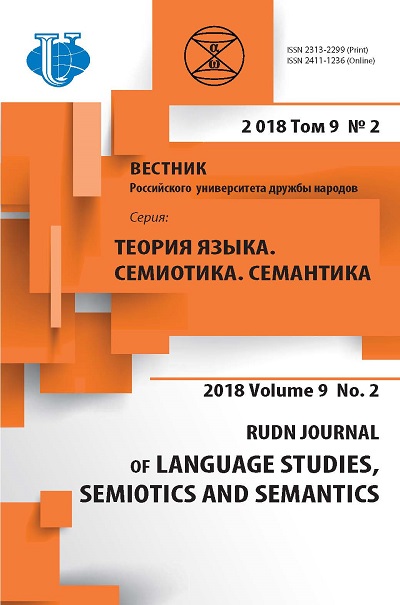TRANSLATION OF THE EXTRACTS WITH HUMOROUS EFFECT: CONTRASTIVE ANALYSIS
- Authors: Abaeva E.S.1
-
Affiliations:
- Moscow City University
- Issue: Vol 9, No 2 (2018)
- Pages: 351-364
- Section: Functional and Comparative semantics
- URL: https://journals.rudn.ru/semiotics-semantics/article/view/18748
- DOI: https://doi.org/10.22363/2313-2299-2018-9-2-351-364
- ID: 18748
Cite item
Full Text
Abstract
The article deals with the idea of changing general system how to decompose the extracts with humorous effect when carrying out the contrastive analysis of the original text and its translation. The previously used system of translation techniques based on a language structure doesn’t always have a positive effect on the results of the contrastive analysis of these texts. The author suggests using General theory of verbal humour (GTVH), created by S. Attardo semantic theory of humour (V. Raskin). The essential parameter is script opposition. The paper having one source text and two target texts as the material shows the advantages of the theory to find out differences and similarities in the system «original text/ translation», as well as in the system «translation 1 / translation 2». The author believes that changing the perspective for contrastive analysis with the help of the new system applied we can describe the translation procedure in more details, as well as demonstrate his/her strategy and explain the variability in linguistic means usage. Moreover, the new approach helps us explain some possible translation failures more objectively and carry out the contrastive analysis of two variants of translation of one source text, if necessary. The observations and conclusions, presented as the results in the paper, could be important for the development of humour translation theory in general and for practice in the sphere of literary translation in particular.
About the authors
Evgeniya Sergeevna Abaeva
Moscow City University
Author for correspondence.
Email: abaevaes@bk.ru
Candidate of Philology, docent, associate professor at the English Studies and Cross-cultural Communication Department, at Moscow City University; scientific interests: translation studies, cognitive linguistics, semantics
2-nd Sel'skohozjajstvennyj proezd, 4, Moscow, Russia, 129226References
- Komissarov, V.N. (2017). Modern Translation Studies. M.: R. Valent. (In Russ.).
- Hoey, M., Houghton, D. (2005). Contrastive analysis and translation. In: Routledge Encyclopedia of Translation Studies. Taylor and Francis e-Library, 45—49.
- Reformatskij, A.A. (1987). Contrastive analysis. In: Linguistics and poetics. Moscow. (In Russ.).
- Chiaro, D. (2012). Translation, Humour and Literature. Translation and Humour. Vol. 1. London: Bloomsbury Academic.
- De Rosa, G.L., Bianchi, F., Laurentiis, A. de, Perego, E. (2014). Translating Humour in Audiovisual Texts. Bern: Peter Lang.
- Vandaele, J. (2010). Humor in translation. In: Handbook of translation studies. Vol. 1, 147—152.
- Mel'nikov, G.P. (1973). Systematic approach in linguistics. In: System studies. Annual 1972. Moscow: Nauka publ.,183—204. (In Russ.).
- Brône, G., Feyaerts, K., Veale, T. (2015). Cognitive Linguistics and Humour. Berlin: Mouton de Gruyter.
- Zlobin, A.N. (2012). Translation in the frame of cognitive knowledge: monograph. Saransk: Mordovia State University Publ.
- Attardo, S. (1994). Linguistic theories of humor. Berlin; New York; Walter de Gruyter.
- Attardo, S. (2001). Humorous texts: a Semantic and Pragmatic Analysis. New York; Mouton de Gruyter.
- Dynel, M. (2013). Developments in Linguistic Humour Theory. Amsterdam: John Benjamins.
- Raskin, V. (1985). Semantic mechanisms of humour. Dordrecht/Boston/Lancaster: D. Reidel Publishing Company.
- Minsky, M. (1980). A framework for representing knowledge. In: Frame conception and text understanding. Vol. 5. Berlin, New York: Gruyter.
- Nida, E.A. (1964). Toward a Science of Translating, Leiden.
- Seguinot, C. (1997). Accounting for variability in translation. In: Cognitive processes in translation and interpreting. Sage Publications, 104—119.
- Modestov V.S. (2006). Literary translation: history, theory, practice. M.: ‘Maxim Gorky Institute of Literature and Creative Writing’ Publ. (In Russ.).
- Boldyrev, N.N. (2016). Cognitive schemas of linguistic interpretation. Voprosy Kognitivnoy Lingvistiki, 4, 10—20. (In Russ.).
- Baker, M. (2011). In Other Words. A coursebook on translation. London & New York: Routledge.
- Robinson, D. (2014). Becoming a translator. Theory and practice of translation. M.: Valent. (In Russ.).
- Denisenko, V.N. (2016). Language system modelling. In: The Systematic Approach as the Basis of Philology. M.: Publishing house YaSK. 37—171. (In Russ.)
- Abaeva, E.S. (2017). Translation units when working with humorous effect. Bulletin of Chelyabinsk State University, 6(402). Philology Sciences. Iss. 106, 5—11. (In Russ.).
- Abaeva, E.S. (2017). Translation the extracts with humorous effect created on the basis of script opposition [animate]/[inanimate]. Vestnik MCU. Series: Philology. Theory of Linguistics. Linguistic Education, 2, 72—80. (In Russ.).
- House, J. (2014). Translation quality assessment: Past and Present. In: Translation: a multidisciplinary approach. Palgrave Macmillan.
- Kazakova, T.A. (2015). Strategies of Literary Translation. Journal of Siberian Federal University. Humanities & Social Sciences, 8(12), 2842—2847. doi: 10.17516/1997-1370-2015-8-12-2842-2847.
Supplementary files












